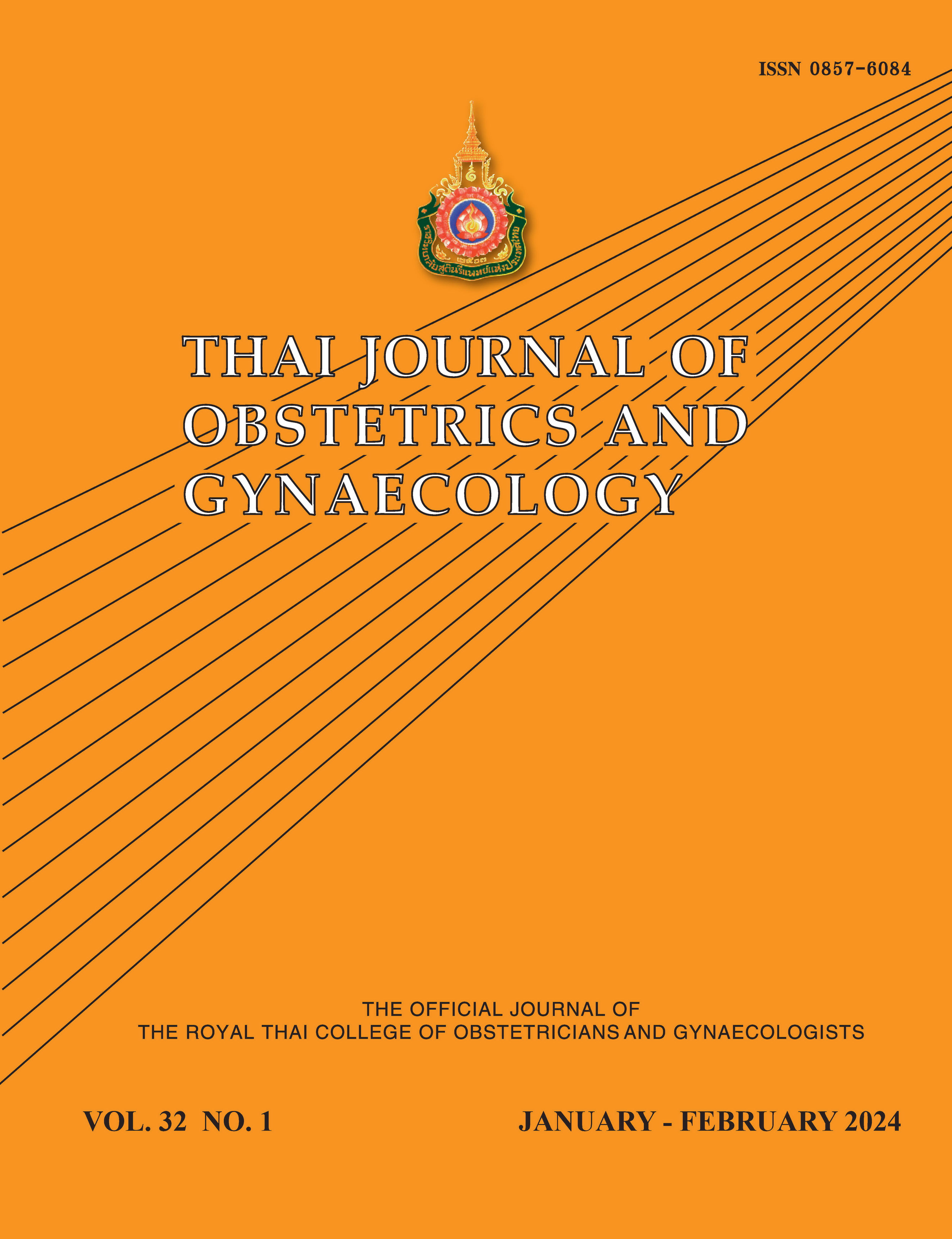Development and Validation of a Prediction Score for Spinal-anesthesia Induced Hypotension in Cesarean Delivery: A prospective cohort study
Main Article Content
Abstract
Objectives: Spinal anesthesia-induced hypotension is the most common complication in cesarean delivery, which can impede uteroplacental blood flow and may deteriorate maternal and fetal welfare. A good predictor for hypotension can help individualized prophylactic treatment. There is currently no simple and good prediction score for spinal hypotension. We conducted a study to develop and internally validate a risk scoring scheme to predict spinal anesthesia-induced hypotension in cesarean delivery.
Materials and Methods: We performed a prognostic clinical prediction model in a prospective cohort design. The parturients who underwent cesarean delivery using spinal anesthesia were included. The outcome was spinal anesthesia-induced hypotension. Predictors included patients’ baseline characteristics, pregnancy details, and preoperative hemodynamic results. Multivariable logistic regression was used for score derivation. Model discrimination and calibration were assessed. The risk score was categorized into low-, moderate-, and high-risk groups.
Results: For 712 parturients who underwent cesarean delivery, a risk score was developed from three predictors: stroke volume index, baseline heart rate, and uterine contraction. The area under the receiver operating characteristic curve was 0.715 (95% confidence interval 0.676-0.754). The risk scores ranged from 0 to 7. When the scores were classified into low- (< 2.5), moderate- (2.5-4.5), and high- (> 4.5) risk groups, the probability of developing hypotension increased from 21.88% in low-risk to 79.95% in the high-risk group.
Conclusion: A risk score developing from stroke volume index, baseline heart rate, and uterine contraction may help predict spinal hypotension in cesarean delivery and guide individualized prophylactic therapy.
Article Details

This work is licensed under a Creative Commons Attribution-NonCommercial-NoDerivatives 4.0 International License.
References
Eltzschig HK, Lieberman ES, Camann WR. Regional anesthesia and analgesia for labor and delivery. N Engl J Med 2003;348:319-32.
Koković JT, Radunovic N, Filimonović D, Nejković L, Arsenijević L, Mirković LJ, et al. Maternal hemodynamic influence on uteroplacental oxygen distribution during cesarean section. Clin Exp Obstet Gynecol 2015;42:610-3.
Butwick AJ, Columb MO, Carvalho B. Preventing spinal hypotension during Caesarean delivery: what is the latest. Br J Anaesth 2015;114:183-6.
Fu F, Xiao F, Chen W, Yang M, Zhou Y, Ngan Kee WD, et al. A randomised double-blind dose-response study of weight-adjusted infusions of norepinephrine for preventing hypotension during combined spinal-epidural anaesthesia for Caesarean delivery. Br J Anaesth 2020;124:e108-e114.
Yu C, Gu J, Liao Z, Feng S. Prediction of spinal anesthesia-induced hypotension during elective cesarean section: a systematic review of prospective observational studies. Int J Obstet Anesth 2021;47:103175.
Frölich MA, Caton D. Baseline heart rate may predict hypotension after spinal anesthesia in prehydrated obstetrical patients. Can J Anaesth 2002;49:185-9.
Bishop DG, Cairns C, Grobbelaar M, Rodseth RN. Heart rate variability as a predictor of hypotension following spinal for elective caesarean section: a prospective observational study. Anaesthesia 2017;72:603-8.
Erango M, Frigessi A, Rosseland LA. A three minutes supine position test reveals higher risk of spinal anesthesia induced hypotension during cesarean delivery. An observational study. F1000Res 2018;7:1028.
Dahlgren G, Granath F, Wessel H, Irestedt L. Prediction of hypotension during spinal anesthesia for Cesarean section and its relation to the effect of crystalloid or colloid preload. Int J Obstet Anesth 2007;16:128-34.
Duggappa DR, Lokesh M, Dixit A, Paul R, Raghavendra Rao RS, Prabha P. Perfusion index as a predictor of hypotension following spinal anaesthesia in lower segment caesarean section. Indian J Anaesth 2017;61:649-54.
Sun S, Liu NH, Huang SQ. Role of cerebral oxygenation for prediction of hypotension after spinal anesthesia for caesarean section. J Clin Monit Comput 2016;30:417-21.
Elbadry AA, El Dabe A, Abu Sabaa MA. Preoperative Ultrasonographic evaluation of the internal jugular vein collapsibility index and inferior vena cava collapsibility index to predict post spinal hypotension in pregnant women undergoing caesarean section. Anesth Pain Med 2022;12:e121648.
Yokose M, Mihara T, Sugawara Y, Goto T. The predictive ability of non-invasive haemodynamic parameters for hypotension during caesarean section: a prospective observational study. Anaesthesia 2015;70:555-62.
Meirowitz N, Katz A, Danzer B, Siegenfeld R. Can the passive leg raise test predict spinal hypotension during cesarean delivery? An observational pilot study. Int J Obstet Anesth 2012;21:324-8.
Bishop DG, Cairns C, Grobbelaar M, Rodseth RN. Obstetric spinal hypotension: Preoperative risk factors and the development of a preliminary risk score - the PRAM score. S Afr Med J 2017;107:1127-31.
Hodgson LE, Venn R, Forni LG, Samuels TL, Wakeling HG. Measuring the cardiac output in acute emergency admissions: use of the non-invasive ultrasonic cardiac output monitor (USCOM) with determination of the learning curve and inter-rater reliability. J Intensive Care Soc 2016;17:122-8.
Collins GS, Reitsma JB, Altman DG, Moons KG. Transparent reporting of a multivariable prediction model for individual prognosis or diagnosis (TRIPOD): the TRIPOD Statement. Br J Surg 2015;102:148-58.
Klöhr S, Roth R, Hofmann T, Rossaint R, Heesen M. Definitions of hypotension after spinal anaesthesia for caesarean section: literature search and application to parturients. Acta Anaesthesiol Scand 2010;54: 909-21.
Peduzzi P, Concato J, Kemper E, Holford TR, Feinstein AR. A simulation study of the number of events per variable in logistic regression analysis. J Clin Epidemiol 1996;49:1373-9.
Clark RB. Hypotension and Caesarean section. Br J Anaesth 2008;101:882-3.
Bonapace J, Gagné GP, Chaillet N, Gagnon R, Hébert E, Buckley S. No. 355-Physiologic Basis of pain in labour and delivery: An wvidence-based approach to its management. J Obstet Gynaecol Can 2018;40: 227-45.
Ripollés Melchor J, Espinosa Á, Martínez Hurtado E, Casans Francés R, Navarro Pérez R, Abad Gurumeta A, et al. Colloids versus crystalloids in the prevention of hypotension induced by spinal anesthesia in elective cesarean section. A systematic review and meta-analysis. Minerva Anestesiol 2015;81:1019-30.


